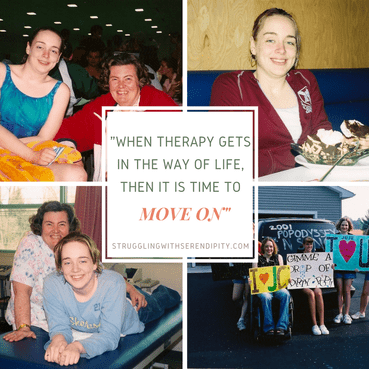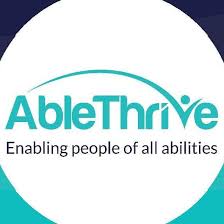|
(This blog tells my family's story. To see more, click "blog" at the top of this webpage.)
With growing confidence, Beth filled her time with the school newspaper, homework, volunteering, clubs, Raptors, and another high school musical. She also decided to get back in the pool as soon as the doctor’s ban ended. Towards the end of Beth’s sophomore year of high school, she was free to go to Green Springs for physical therapy once instead of twice after school. “Laraine said that when therapy gets in the way of life, then it is time to move on,” Beth explained. The last physical therapy session, almost two years post-injury, ended with the anticipated rite of passage. The final test: while Beth dramatically finished her last pushup, she pushed off her favorite therapist who was leaning on her back. Laraine dramatically stepped away. Everyone clapped. A sad and happy moment, the end of an era, though we would continue to meet Laraine and her students in Toledo every few months. “I continued physical therapy as an outpatient for two years,” Beth said. “Three times a week at first then going to twice and then once a week, we drove to St. Francis after school to workout for about two hours. Recently I ‘graduated’ from physical therapy since I get plenty of exercise on my own now and since I always am extremely busy.” At another seminar for physical therapy students, Beth enthusiastically shared a milestone. Leaning back in her wheelchair, she took an elastic band off her wrist and held it in her teeth. She used both hands and arms to scoot forward in the chair and then lean back. From that position, she reclaimed the elastic with the one finger she could move. Her smile wavered a moment as she concentrated on intricate degrees of progress. When the second loop secured a messy ponytail, she took a bow with a flourish and a ta-dah! Sweet 16 on her April birthday, Beth returned to the water. A physical therapy student, Colleen, offered to help at the University of Toledo pool on a Saturday. After observing the usual floating with arms waving underwater, Colleen, a college swimmer, provided advice and a hand of support under her back while Beth rotated her arms, one at a time. Next, they tried circling both arms together, causing her head to dip under water. None of it came naturally. Beth had water safety lessons as a toddler, but had never been a swimmer before the accident. With the first wheelchair games a week away, we met Colleen a second time. They focused on the traditional, alternating backstroke, taxing muscles and stamina. For the first time, she could swim the backstroke—awkward and faltering. Beth slept through the hour ride home, dreaming. Here’s Beth's video on how she puts her hair up: www.ablethrive.com/basics/putting-hair-up-in-a-ponytail
4 Comments
 (This blog tells my family's story. To see more, click "blog" at the top of this webpage.) Beth’s second year of high school would hold different challenges than the first. When she started her sophomore year, sixteen months after her injury, I could get through the days without crying in front of anyone, a victory of sorts. “My small group of really close friends in high school helped me in many ways,” Beth said, “including breaking my leg spasms and carrying my book bag. By the second year I had those things under control, but a friend continued to sit by me in class only because it was more fun that way.” I took a short cut through the school cafeteria on September 11th at lunchtime and paused by a strange crowd of silent students in front of the television screen. It took only a moment to get my first glimpse of unthinkable tragedy. I rushed to the locker room, relieved to find Beth and Maria waiting for me. Hugged close and safe, for the moment. I grieved with the nation, overwhelmed by the scale of the losses and the faces of children who would never grow up. My worst-case scenarios amplified after 9/11. Terrorism took on a life of its own in my mind, growing and mutating into an on-going and imminent threat. I tried to tap down the fear by storing bottled water in the basement and packing an emergency duffle bag. I wrote phone numbers and a meeting place on a small rectangle of paper, copied and laminated for each member of my immediate family to carry in their wallet. An article that I read caused me more worry, about the terrible knowledge that nuclear weapons had already been used in the past, and might be used again. My heightened fears grouped nuclear weapons with terrorism and a deadly virus. Toxic chemical spills were a high risk in Ohio with the heavy truck traffic. And a personal, selfish anxiety about any number of alarming events that could restrict prescription drugs; I was acutely aware of my addictions with antidepressants and pain medicine (not opiods, thankfully). Who would I be without the prescriptions? How would I help Beth? The very worst part of my anxiety was feeling helpless—powerless, useless—to protect my family. My counseling sessions after 9/11 were more emotional. My psychologist patiently explained to me that widespread catastrophe would be highly unlikely, as though that would comfort me. The tragedy of 9/11 had been unlikely. Our car accident and Beth's injury had been unlikely, too. I really (really) wanted to be optimistic, and picked up books at the library with positive messages. I wished that getting rid of anxiety could be as simple as just choosing not to worry. Just choosing to have hope. When Beth asked to go to the YMCA a few times a month, I read books on the pool deck while she moved on her back with her arms waving slowly underwater. I no longer needed to watch continually for her head dipping too long under the water. When I drove to Green Springs after school for physical therapy, Laraine encouraged her to keep swimming. Though technically, she was floating. I joined Beth in the water one Sunday at her request. She wanted to try the backstroke. The effort to rotate her arms out of the water caused her to sink. I splashed my face to hide my tears as I lifted her up. We had no way of knowing that the backstroke would be her fastest swim stroke.  (This blog tells my family's story. To see more, click "blog" at the top of this webpage.) The pneumonia winter gave way to spring before Beth felt well enough to request swimming at the YMCA. She attempted to put on a bathing suit by herself at home, much harder than other clothing, but accepted my help to finish. At the pool, I stayed with her in the water, watching as she floated on her back and waved her arms gently underwater. She stayed in the pool about twenty minutes with frequent breaks at the walls. I lifted her out of the water carefully to avoid scraping her back. Even so, the concrete walls left her lower extremities with abrasions that healed slowly. She wouldn’t consider any kind of protective coverings for her legs or feet, except for a few waterproof bandaids on the worst of the scrapes. Against my advice, Beth sang at tryouts for the high school musical Guys and Dolls. With the pneumonia week in the hospital fresh on my mind, I stressed about her taking on too much. With two of her best friends, Ellen and Jackie, she bypassed the stage steps and took the long way through the choir room to the stage. I drove Beth and Maria to and from rehearsals and we shopped for costumes at Goodwill. When a tornado watch started with a rehearsal underway, I returned to school early to pick them up and hurry to our basement. Ohio’s tornado season escalated in significance for my family. Previously, John would monitor the weather during watches and we very rarely camped out in our partially finished basement. No more. Beth felt compelled to heed every warning and watch at once, so we carried her down the steep basement steps. She couldn’t relax until everyone stayed in the basement, including Timber. The growing parrot sat heavily on her shoulder and played with her hair while she completed homework. When Timber hopped onto the papers in her lap, she prompted with his first words, up up, for him to jump on her hand. One stormy midnight, Beth insisted on a family trek to the basement during a long tornado warning, not a watch. Losing sleep, she admitted her anxiety, similar to her response to the low gasoline light in the car. I offered to find a good counselor for her, but she emphatically declined. A weekday afternoon when Beth stayed home with John, I sat in the bleachers at the softball field and watched Maria play on the high school team. A hard hit ball connected with the head of a girl from the other school. An ambulance drove right onto the outfield with lights blazing and sirens wailing. Maria didn’t hit the ball that hurt the girl, but the ambulance brought back unwelcome memories for both of us. We hugged behind the bleachers in tears. The year anniversary of Beth’s injury approached.  (This blog tells my family's story. To see more, click "blog" at the top of this webpage.) Eager to get back in the water, Beth asked for a schedule of open swim times at the Green Springs rehab center. I never—ever—suggested going to a pool. Life was too overwhelming. However, I rarely questioned or discouraged her ideas. Plagued by guilt, I felt like the last person who should say no. In the warm water pool with me instead of a therapist, Beth moved to a floating position by herself after hanging on at the wall. After a few laps, she asked about something new. In the middle of the lane, after sinking, she tried to get on her back to float (and breathe), but without a wall to grab onto, she couldn't keep her head above water long enough to get on her back. Yet. Afterwards, the rehab locker room overflowed with elderly ladies getting ready for a class in various states of undress. On the way home, Beth asked to pick up a pool schedule at our local YMCA. I talked to Laraine to find out if a typical pool with a cooler temperature might trigger autonomic dysreflexia, and she said yes. I needed to be alert for flushing of the skin, a pounding headache, sudden changes in heart rate, and dizziness. And high blood pressure that could trigger a stroke. I put a blood pressure monitor in her swim bag. “I taught myself how to swim on my back independently,” Beth said. “I slowly progressed to swimming laps at the YMCA.” At Tiffin’s one indoor pool, I lowered her from her wheelchair to the deck and then again into the cool water. No scary symptoms surfaced. The pounding headache belonged to me. I stayed close in the water and followed her leisurely floating back and forth, arms waving under the surface. It appeared to be smooth sailing, but I knew better. Turning around at the wall alone required strenuous exertion. Ten minutes with frequent long breaks made her arms tremble. The lifeguard didn’t know how to operate the sling lift, so I squatted at the edge of the deck. With Beth in the water with her back to the wall, I reached under both of her arms and pulled up, thoroughly scraping her back in the process. I felt like an awful mom. I couldn’t lift her from the deck to the wheelchair by myself, so I asked the lifeguard to grab her knees while I lifted under her shoulders. Others stared as both of her legs extended in bouncing spasms. I bent her knees and put her feet back on the footrests as quickly as possible. I had more lessons to learn. The second time at the YMCA pool, Beth’s foot twisted in the metal of the wheelchair when I lowered her to the deck. My fault. I had focused on a smooth transfer, not on her feet. She felt no pain, but spasms intensified in her legs, her body’s indicator of a problem. She tried floating, but too many spasms made her uncomfortable. I managed to lift her out of the pool without scraping the slow-healing scabs on her back. The next day, Dr. Miller examined the swollen foot and an x-ray, too early for the stress fracture to show. She prescribed a muscle relaxant to tone down the spasms. The foot would heal on its own without any weight on it. I was grateful that Beth couldn't feel the pain of the injury, but it felt like an odd kind of gratitude. I couldn't refrain from wishing that she could stand and walk—and yes, feel pain in her legs and feet, too.  (This blog tells my family's story. To see more, click "blog" at the top of this webpage.) After I quit my job at the high school, our new normal changed for me from an onslaught to simply overwhelming. Beth attended school most days and I met her there over her lunch period. Life continued to be exhausting. Even so, Beth looked forward to physical therapy. I watched her complete the beginning steps of a therapy session in November, six months after her injury. Progress was obvious. She no longer needed complete assistance with hand-over-hand guidance, but she also could not move out of her chair independently. Laraine caught Beth when she tipped too far forward to pull a wheelchair brake, helped her scoot over on a sliding board, and steadied her as she sat up on the mat table. At a time when every movement on land required focused exertion, Beth found unexpected freedom in the water. Not a swimmer before the injury, she needed more trials with more sinking before she could stay afloat on her back for more than a few moments. Waving her arms underwater moved her backwards. When she lost her balance and tipped over, she couldn’t get back in a floating position or get to the edge of the pool by herself—or get her head up to breathe. At the pool wall, she held herself up with both hands, then tried and failed, over and over, to get on her back without help. Weeks later, Beth invited Laraine and Jill to her last therapy session in the rehab pool. In the water with another therapist, my youngest attempted to float on her own, unsuccessfully. Sinking, she worked her arms in a burst of effort, raised her head, reached up to the wall with both hands, and caught her breath. After another try, she positioned herself on her back and waved her arms underwater to stay afloat, to breathe, and to move very slowly across the small pool. Eventually reaching the opposite wall, she grabbed the ledge with effort, using both hands. In an impressive feat of balance, Beth achieved a floating position independently again and dragged along a sinking trunk and legs through another lap. “Once she entered the water, wow,” Jill said. “It was awesome!” Seven years later, after setting 14 Paralympic American Records, Beth told a Harvard reporter, “I discovered I had good water technique and was able to keep myself afloat pretty well. Not at the beginning—it obviously took me awhile to learn how to swim.”  (This blog tells my family's story. To see more, click "blog" at the top of this webpage.) During a brief respite from antibiotics, Beth set in motion a far-reaching odyssey, one that would lead to unexpected adventures in and out of the water. I watched as two therapists held her up in the rehab pool, one on each side and both on the lookout for autonomic dysreflexia, which thankfully did not occur. After a few exercises, Beth asked to float, a complicated endeavor with no command of the lower body. Fully supported on her back, she asked them to let go. They resisted at first, but eventually agreed, with a swift rescue a moment later. “I immediately loved the water and the freedom I had in it.” She talked them into more floating attempts while the therapists tactfully suggested moving on to more exercises. When she was a toddler, Beth had perfected the art of pleasantly talking her way in or out of most anything with a dimpled smile. John called her our little lawyer. The second time at the pool, the therapists bent to Beth’s persuasion again, positioning her body horizontally and letting go, over and over. They also taught her how to roll over from a face-down position, but she couldn’t do that or anything else in the water. At the third session, one therapist assisted in the pool instead of two. Experimenting, Beth discovered that moving her arms underwater allowed her to float on her own for a few seconds, with a bonus: backwards movement. “No one expected me to ever move in the water without someone holding me up.” |
Cindy KolbeSign up for my Just Keep Swimming Newsletter by typing your email address in the box. Thanks!Categories
All
Archives
November 2022
|


 RSS Feed
RSS Feed











